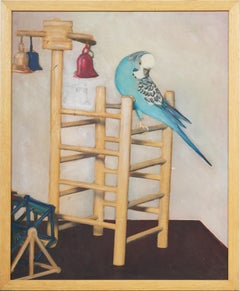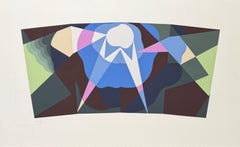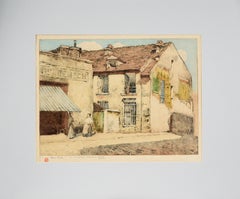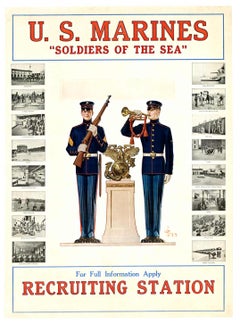1910s Art
to
270
1,091
357
395
191
171
Overall Width
to
Overall Height
to
7,567
21,304
159,313
232,436
1,975
2,257
4,946
6,422
5,840
13,335
19,800
25,719
18,319
13,594
5,389
420
314
138
137
47
20
19
12
6
1
1,232
891
31
1,436
693
596
412
387
354
220
152
145
138
133
122
116
101
97
94
77
77
60
57
869
628
488
396
386
102
53
34
23
23
854
372
1,172
960
Period: 1910s
Antique American Impressionist Parrot Portrait Interior Scene Framed Painting
Located in Buffalo, NY
Impressive early American impressionist parrot portrait oil painting. Framed. Oil on board. Image size, 20H by 16L.
Category
Impressionist 1910s Art
Materials
Canvas, Oil
$1,980 Sale Price
20% Off
Art Deco Watercolor 1918, By Otto Lendecke Decorated Salon Helena Rubinstein
Located in Eltville am Rhein, DE
Otto Friedrich Carl Lendecke
Lemberg 1886 - 1918 Vienna
Ich werde beobachtet!
I am being watched!, 1918
Watercolor and pencil on paper / cardboard
Signed and dated lower left, tit...
Category
Art Deco 1910s Art
Materials
Watercolor
Giacomo Balla (1871–1958) - Balla futurista - Colour screen printing on paper
Located in Varese, IT
Colour screen printing on paper, edited 1914
Posthumous Edition issued by Balla Archive
Limited Edition of 150 copies
Numbered in pencil on the lower left 40/150
Paper size: 56 x 92 ...
Category
Abstract 1910s Art
Materials
Screen
Portrait of Two Sisters by a Window - British 1918 Slade School art oil painting
By Clive Gardiner
Located in Hagley, England
This charming British Post Impressionist portrait oil painting is by noted Slade School artist (Alfred) Clive Gardiner. It was painted in 1918 and shows the influence of the French a...
Category
Post-Impressionist 1910s Art
Materials
Oil
Women Outside Breton Hotel - Chromolithograph on Paper
Located in Soquel, CA
Women Outside Breton Hotel - Chromolithograph on Paper
In a pastel palette, Alson Skinner Clark (American, 1876-1949) captures the rustic beauty of a side street in a Breton village as two women converse outside of a hotel on a blue sky day.
Signed “Alson Clark...
Category
American Impressionist 1910s Art
Materials
Laid Paper, Lithograph
$2,000 Sale Price
20% Off
Original U. S. Marines, Soldiers of the Sea vintage WW1 poster linen backed
Located in Spokane, WA
Original U.S. Marines "Soldiers of the Sea" vintage poster by J.C. Leyendecker (c. 1917); linen-backed in A-, B+ condition, ready to frame.
The poster h...
Category
Art Deco 1910s Art
Materials
Offset
Portrait de Mme De Mornand - Ink on Paper by Maurice Lourdey - 1910
Located in Roma, IT
Portrait de Mme de Mornand is an original drawing in ink on paper realized by Maurice Lourdey (1860-1934)
Dated on the upper right 22.02.10
Stamp on the lower right ""CJ"
Good con...
Category
Art Nouveau 1910s Art
Materials
Ink
Traum - Etching by Fritz Schwimbeck - 1918
Located in Roma, IT
Etching realized by Fritz Schwimbeck in 1918.
Edition of 125 realized in Munich on mulberry paper.
Hand signed in pencil.
Category
Symbolist 1910s Art
Materials
Etching
Figures on a Woodland Path - British Edwardian art landscape oil painting
Located in Hagley, England
This charming British Edwardian oil painting is attributed to the circle of Tom Mostyn. Painted circa 1910 it is a wooded landscape with figures stopping to rest on a path bathed in ...
Category
Impressionist 1910s Art
Materials
Oil
$4,805 Sale Price
20% Off
Autumn walk
Located in Genève, GE
Work on cardboard
Beige wooden frame
48 x 40.5 x 3.8 cm
Category
1910s Art
Materials
Oil
"Late Afternoon at Brighton Beach"
Located in Lambertville, NJ
Jim’s of Lambertville Fine Art Gallery is proud to present this piece by Martha Walter (1875 - 1976).
Born in Philadelphia in 1875, Martha Walter attended Girls’ High School followe...
Category
American Impressionist 1910s Art
Materials
Canvas, Oil
1915 Imagerie d'Épinal N. 15 by O'Galop for the final exploits of Roland Garros
Located in PARIS, FR
The 1915 Imagerie d'Épinal N. 15, created by the renowned artist O'Galop, celebrates one of the final exploits of Roland Garros, the legendary French aviator. This print was part of ...
Category
1910s Art
Materials
Linen, Paper, Lithograph
Portrait of Emily Gertrude Muirhead - British Italian 1910 art oil painting
Located in Hagley, England
This superb Portrait oil painting is by noted Italian born artist Pilade Bertieri. Painted circa 1910, Bertieri had a London address in 1908 and exhibited five pictures at the Royal ...
Category
Realist 1910s Art
Materials
Oil
1910 originalposter for the Chemins de fer de l'État - Excursion en Normandie
Located in PARIS, FR
Charles Hallé's 1910 poster for the Chemins de fer de l'État, titled "Excursion en Normandie," stands as a picturesque journey to the heart of Normandy's...
Category
1910s Art
Materials
Linen, Paper, Lithograph
A Night in Paris - Mixed Media on Paper by P. Scoppetta - 1911
By Pietro Scoppetta
Located in Roma, IT
A Night in Paris is an original decorative object realized by Pietro Scoppetta in 1911.
Mixed media on paper.
Hand-signed and dated on the lower left corner: Pietro Scoppetta 1911.
A frame is included.
Very good conditions.
Very elegant, beautiful impressionistic work realized in the first years of the XX Century by the important Italian artist Pietro Scoppetta. The work is characterized by a very impressionistic stroke and touch and depicts a scene during a Parisian night. The figures of the woman in the streets are only sketched but we can feel the elegance and the beauty of the Paris during the fin du siècle.
The work has been realized by Pietro Scoppetta (Amalfi, 1863 - Neaples, 1920) an Italian artist. He dedicated himself initially to architectural studies, he abandoned them to form artistically, under the guidance of Giacomo Di Chirico. Resident in Naples, he had the opportunity to live in a climate of strong movements of cultural evolution. Scoppetta decided to leave Italy for abroad, and stayed a long time in London and Paris. In Paris, where he lived between 1897 and 1903, he joined the large group of Neapolitan painters, attracted by the bourgeois suggestions of the Belle Époque, including Lionello Balestrieri...
Category
1910s Art
Materials
Mixed Media
Etching 1916 Number II
Located in New York, NY
Wassily Kandinsky (1866-1944), Etching 1916 Number II, drypoint, signed in pencil lower right, titled, numbered (No. 9) and dated lower left [also with initials and date in the plate lower right]. Reference: Roethel 154, only state, edition of 10. In excellent condition (the barest handling fold at sheet edge), printed on a heavy ivory wove paper, the full sheet with full margins, 4 7/8 x 3 1/4, the sheet 17 1/2 x 13 inches, archival mount with window mat.
A fine fresh impression of this great rarity, printed in a dark brown ink.
Kandinsky created this drypoint (erroneously named Etching 1916) in early 1916 while staying with Gabriel Munter in Stockholm during the winter of 1915-16. This is from the second series of drypoints he made; the first was in the year 1913-14.
Provenance: Kornfeld Auction, Bern, June 2007.
The tiny size of this edition (10) makes this print a great rarity within the Kandinsky’s printed...
Category
Abstract 1910s Art
Materials
Drypoint
R. Layni, Zeichnungen folio, "Seated Woman with Bent Knee" Collotype plate I
Located in Palm Beach, FL
After Egon Schiele (1890 – 1918), AUSTRIA
“ART CANNOT BE MODERN, ART IS PRIMORDIALLY ETERNAL.” -SCHIELE
Defiantly iconoclastic in life and art, Egon Schiele is esteemed for his mas...
Category
Vienna Secession 1910s Art
Materials
Paper
Gustav Klimt "Study for Water Serpents" collotype from Funfundzwanzig folio
By Gustav Klimt
Located in Palm Beach, FL
Title page numbered: 263/450
Category
Vienna Secession 1910s Art
Materials
Paper
1916 original poster by Richard Gutz war bonds through the Banque Nationale
Located in PARIS, FR
The 1916 original poster by Richard Gutz, titled "Souscrivez pour la victoire - Banque nationale de crédit", is an evocative piece of wartime propaganda produced during the height of...
Category
1910s Art
Materials
Linen, Paper, Lithograph
Bayros-Mappe III - Héliogravu by Fraz von Bayros - 1913
Located in Roma, IT
Héliogravure on japanese paper realized by Fraz von Bayros in 1913 for Ex Libris Verlag K. Th. Senger, Munich.
Mounted on passepartout. Edition of 260, hand signed in pencil by the ...
Category
Symbolist 1910s Art
Materials
Photogravure
Reclining Man Ashcan Early 20th Century American Scene Social Realism Gay Nude
By Isidore Konti
Located in New York, NY
"Reclining Man" Ashcan Early 20th Century American Scene Social Realism Gay Nude
Isadore Konti (1862 - 1938)
"Reclining Man"
7 1/2 w x 4 1/2 d x 7 high inch...
Category
American Realist 1910s Art
Materials
Bronze
"Golden Harbor, Gloucester" Lillian Mathilde Genth, Golden Hour, Reflections
Located in New York, NY
Lillian Mathilde Genth
Golden Harbor, Gloucester, circa 1910
Signed lower right, titled in graphite on verso
Oil on canvas
20 x 25 inches
Born in Philadelphia, Lillian Mathilde Gen...
Category
American Impressionist 1910s Art
Materials
Canvas, Oil
1917 original poster by Abel Faivre - 3e Emprunt de la Défense Nationale
By Jules-Abel Faivre
Located in PARIS, FR
The 1917 original poster by Abel Faivre, titled “3e Emprunt de la Défense Nationale – Crédit Lyonnais – Liberté”, is a striking example of World War I propaganda, blending art with p...
Category
1910s Art
Materials
Paper, Lithograph
"Derby Day" 48 Framed Playing Cards/ Jockey/ Horse Racing"
Located in Bristol, CT
Art Sz: 19 1/2"H x 21 1/2"W
Frame Sz: 25 1/2"H x 26 7/8"W
Each card measures 2 1/4" x 3 1/2"
The Parker Games Co Ltd London
Derby Day race game published by Parker Games’ English...
Category
1910s Art
Materials
Cardboard
Oil Painting Pair by Robert Watson "Highland cattle and Sheep in the Glen"
Located in Mere, GB
Oil Painting Pair by Robert Watson "Highland cattle and Sheep in the Glen" A Cheshire painter of Highland cattle and sheep represented in the Harris museum Preston. Both oil on canv...
Category
1910s Art
Materials
Oil
Louis Valtat Mere Et Enfant Monumental Oil Painting
By Louis Valtat
Located in Dallas, TX
Louis Valtat (French, 1869-1952) Fauvist Oil painting of a mother and child.
A very large painting by Louis Valtat titled Mere et Enfant (Mother and C...
Category
Fauvist 1910s Art
Materials
Canvas, Oil
"baia della Francia del nord" Olio cm 21 x 15 1910 ca
Located in Torino, IT
Piccola pittura a olio ,luminoso paesaggio della Bretagna francese, molto luminoso,splendida cornice
Category
Impressionist 1910s Art
Materials
Oil, Cardboard
1919 original movie poster for Homunkulus, created by Hans Neumann
By Hans Neumann
Located in PARIS, FR
The 1919 original poster for Homunkulus, created by Hans Neumann, is a striking example of early 20th-century film advertising, capturing the spirit of the silent film era with bold ...
Category
1910s Art
Materials
Paper, Lithograph
Cornish Family in an Interior - British 1912 Newlyn School art oil painting
Located in Hagley, England
This superb British figurative interior oil painting is by noted Newlyn school artist Harold Harvey. Painted circa 1912 the composition is a Cornish family, bathed in golden light, s...
Category
Realist 1910s Art
Materials
Oil
Harold HarveyCornish Family in an Interior - British 1912 Newlyn School art oil painting, Circa 1912
$43,682 Sale Price
20% Off
“Apple Blossom Time”
Located in Southampton, NY
Here for your consideration is a light filled oil on canvas painting by the American artist, David Clark. The meandering path, apple blossoms. the first ...
Category
Post-Impressionist 1910s Art
Materials
Canvas, Oil
$2,500 Sale Price
26% Off
Paris, Seine. 1918/19, oil on cardboard, 38x52 cm
Located in Riga, LV
Paris, Seine. 1918/19, oil on cardboard, 38x52 cm
Signature located in bottom right corner Belay
The certificate: M. Roland Souef at November 23, 2011
Pierre Savigny de Belay...
Category
Expressionist 1910s Art
Materials
Oil, Cardboard
$9,190 Sale Price
20% Off
Summer Afternoon Firth of Clyde - British exh figurative seascape oil painting
Located in Hagley, England
This lovely Scottish exhibited seascape oil painting is by noted Scottish artist Patrick Downie. It was painted in 1914 and exhibited at the Glasgow Institute of Fine art that year e...
Category
Impressionist 1910s Art
Materials
Oil
$13,104 Sale Price
20% Off
Nude Sketch - Pastel by Michel Simonidy - 1910s
Located in Roma, IT
Nude Sketch is an original artwork realized by Michel Simonidy in the first years of the XX Century.
China ink on paper.
Passepartout is included (cm 19 x 26).
Mint conditions. ...
Category
1910s Art
Materials
Pastel
"Sierra Maestre" Cuban Landscape
Located in Soquel, CA
Idyllic watercolor of grassland and mountains in Cuba by Leonard Lester (English, 1870-1952). A large, grasy field stretches out from the viewer, lush a...
Category
American Impressionist 1910s Art
Materials
Paper, Watercolor
$2,000 Sale Price
20% Off
Auflosung - Etching by Fritz Schwimbeck - 1918
Located in Roma, IT
Etching realized by Fritz Schwimbeck in 1918.
Edition of 125 realized in Munich on mulberry paper.
Hand signed in pencil.
Category
Symbolist 1910s Art
Materials
Etching
Uccidiamo il Chiaro di Luna - Rare Book - 1911
Located in Roma, IT
Third futurist manifesto (wrongly believed to be the second), appeared for the first time with this title on the literary magazine directed by F.T. Marinetti "Poesia", anno V, n.7-8-...
Category
Surrealist 1910s Art
Materials
Paper
TOD UND FRAU (DEATH AND WOMAN)
Located in Portland, ME
Kollwitz, Kathe. TOD UND FRAU (DEATH AND WOMAN). Knesebeck 107, State VII; Klipstein 103. Line etching, drypoint, sandpaper, soft ground with imprint of granulated tone paper and Zie...
Category
1910s Art
Materials
Drypoint, Etching
Peter Pathe - Original Lithograph Poster
Located in Palm Beach, FL
PETER PATHE, poster lithograph, Schnackenberg School, 1919, the image features the headline performer, Peter Pathe, in drag wearing a form-fitting button-down jacket, high-waisted shorts buttoning down the front, Mary Jane dance shoes and calf-length white socks; Pathe is depicted in motion with raised jazz hands which frame his bushy-haired heavily made-up face and body curving in dynamic lateral movement with raised front leg turned out; with printed text at the bottom: “PETER PATHE/und/Fritz Wolf-Killanyi * Renate Ferena/Tia Majja * Else Zimmermann tanzenmit grossem/Orchester (Leitung: Rob. Tants) Donnerstag, 18 Nov., amends 71/2 Uhr im Konzertsaal Hotel “Vier Jahreszeiten”/Karten zu Mk. 20. - bis Mk. 3.- bei Alfr. Schmid Nachf., Residenzstr. 7 und Otto Halbreiter, Promendeplatz 16.”; printed text at mid-right: “M. Pathe/19”; marked with the printer’s stamp in the lower right: “Oscar Consee/Kunstanstalt/Munchen/Valley Str./7-9”; the poster is secured by matting and framed with a plexiglass cover, Boston...
Category
Art Nouveau 1910s Art
Materials
Lithograph
Early Spring, Pastoral Impressionist Oil Painting on Canvas by Ernest Beaumont
Located in Long Island City, NY
Artist: Ernest Beaumont
Title: Early Spring
Year: circa 1910
Medium: Oil on Canvas, signed l.l., signed and dedicated verso "For Frances"
Size: 15 x 18 in...
Category
Impressionist 1910s Art
Materials
Canvas, Oil
Transportation of Marble Blocks - Vintage Photo - 1910s
Located in Roma, IT
Transportation of Marble Blocks is a Silver Salt print realized in the 1910s.
From Alinari archive.
Good conditions and aged.
Category
Modern 1910s Art
Materials
Photographic Paper
1918 original poster "Reserve the Wine for Our Soldiers"
Located in PARIS, FR
This 1918 original poster by Suzanne Ferrand, titled "Réservez le Vin pour Nos Poilus" ("Reserve the Wine for Our Soldiers"), is a powerful piece of World War I propaganda, emphasizi...
Category
1910s Art
Materials
Paper, Lithograph
Transportation of Marble Blocks - Vintage Photo - 1910s
Located in Roma, IT
Transportation of Marble Blocks is a Silver Salt print realized in the 1910s.
From Alinari archive.
Good conditions and aged.
Category
Modern 1910s Art
Materials
Photographic Paper
Transportation of Marble Blocks - Vintage Photo - 1910s
Located in Roma, IT
Transportation of Marble Blocks is a Silver Salt print realized in the 1910s.
From Alinari archive.
Good conditions and aged.
Category
Modern 1910s Art
Materials
Photographic Paper
Sunset River
Located in New York, NY
Johann Berthelsen and one of New York city’s best known artists along with Guy Wiggins, depicting the streets, parks and skyline of New York. This is a romantic and atmospheric work ...
Category
Tonalist 1910s Art
Materials
Paper, Pastel
Harbour Seascape - Scottish Edwardian Impressionist art marine oil painting
Located in Hagley, England
This superb Edwardian Impressionist oil painting by Scottish listed artist James Campbell Noble RSA. Painted circa 1910 the composition is a harbour scene with trees to the right, nu...
Category
Impressionist 1910s Art
Materials
Oil
The lonely man - Original China Ink by Gabriele Galantara - 1910s
Located in Roma, IT
The lonely man, in 1910s, is an original drawing in china ink on creamy paper realized by Gabriele Galantara (1865-1937).
In good conditions.
This is an...
Category
Modern 1910s Art
Materials
Ink
The First Church of Christ Scientist - Early 20th Century Boston Landscape
Located in Soquel, CA
Early 20th Century oil painting of The First Church of Christ Scientist Boston, Massachusetts by Henrietta Dunn Mears (American,1877-1970), 1917. Presented in a giltwood frame. Sign...
Category
American Impressionist 1910s Art
Materials
Canvas, Oil, Cardboard
Bayros-Mappe III - Héliogravure by Fraz von Bayros - 1913
Located in Roma, IT
Héliogravure on japanese paper realized by Fraz von Bayros in 1913 for Ex Libris Verlag K. Th. Senger, Munich.
Mounted on passepartout. Edition of 260, hand signed in pencil by the ...
Category
Symbolist 1910s Art
Materials
Photogravure
France early 20th century, Head of a faun, original drawing
Located in Paris, FR
France, early 20th century
Head of a faun
bears a monogram "P H" on the lower right
Pencil on paper
24.5 x 13 cm
In a period frame (in good condition except a small loss on the upper...
Category
Art Nouveau 1910s Art
Materials
Carbon Pencil
The King - Original Drawing by Gabriele Galantara - 1914
Located in Roma, IT
The king is an original drawing in China ink, watercolor and white lead on creamy cardboard realized by Gabriele Galantara (1865-1937).
In good conditions.
This artwotk presents o...
Category
Modern 1910s Art
Materials
Ink, Watercolor
Preliminary Study for the painting Rose and Gold, 1913
Located in Fairlawn, OH
Preliminary Study for the painting Rose and Gold, 1913
Graphite on paper, 1913
Signed in pencil lower left (see photo)
Titlted "Lizzy Young" in pencil upper left (see photo)
Lizzy was a modle that Paxton depicts numerous times.
The painting that this drawing is related to, is illustrated in Lee & Krause, William McGregor Paxton, 1869-1941, Plate 32, text on page 132. The painting was formerly in the collection of Victor Spark and the Honorable Paul Buchanan. It is currently in a Texas Collection.
Provenance: Private Collection, Florida
William McGregor Paxton (June 22, 1869 – 1941) was an American painter and instructor who embraced the Boston School paradigm and was a co-founder of The Guild of Boston Artists. He taught briefly while a student at Cowles Art School, where he met his wife Elizabeth Okie Paxton, and at the Museum of Fine Arts School in Boston. Paxton is known for his portraits, including those of two presidents—Grover Cleveland and Calvin Coolidge—and interior scenes with women, including his wife. His works are in many museums in the United States.
Early life
He was born on June 22, 1869, in Baltimore to James and Rose Doherty Paxton. William's father moved the Paxton family and established a catering business in Newton Corner, Massachusetts, in the mid-1870s.
Education
Paxton attended Cowles Art School on a scholarship he attained at the age of 18. He studied with Dennis Miller Bunker...
Category
American Impressionist 1910s Art
Materials
Graphite
"Opium" Lithograph Poster by Theo Matejko
By Theo Matejko
Located in Palm Beach, FL
Frame is handmade by artist Gail Potocki.
WEAG-Matejko, Printer, Vienna
"In 1919, artist Theo Matejko created this lithograph for Robert Reinert's silent film Opium (starring Conra...
Category
Expressionist 1910s Art
Materials
Lithograph
Preliminary Drawing for the color aquatint "New Orleans, Street Gossip"
Located in Fairlawn, OH
Preliminary Drawing for the color aquatint "New Orlaens, Street Gossip"
Signed by the artist in pencil lower left
Graphite on tracing paper, 1916-1917
An impr...
Category
American Impressionist 1910s Art
Materials
Graphite
Original lithograph by Poulbot of a scene from the first world war. This lithogr
Located in PARIS, FR
Original lithograph by Poulbot of a scene from the first world war. This lithograph is numbered 36/50 and hand signed by the artist. Francisque Poulbot, born in Saint-Denis on Februa...
Category
1910s Art
Materials
Paper, Lithograph
“Skogskanten” (Winter Landscape with Spruce Trees)
Located in Stockholm, SE
Oskar Bergman (Stockholm 1879–1963 Saltsjöbaden)
“Skogskanten” (Winter Landscape with Spruce Trees)
signed "Oskar Bergman" in pencil
drypoint etching
image size: 19.5 x 29.5 cm (7 ...
Category
Naturalistic 1910s Art
Materials
Paper, Drypoint, Etching
"Peter Pathe Marie Hagan" Original Lithograph Poster by Walter Schnackenberg
Located in Palm Beach, FL
Original vintage lithograph poster with depiction of Munich-based balletic duo Peter Pathe and Maria Hagen. Design by Walter Schnackenberg (German, 1880-1961). A very scarce example....
Category
Art Nouveau 1910s Art
Materials
Lithograph
French Woman with Japanese Inspired Gown - Pencil drawing - circa 1916
Located in Paris, IDF
Georges CONRAD (1874-1936)
French woman with Japanese inspired gown
Original pencil drawing
Signed by stamp of atelier
On paper 26.5 x 20 cm (c. 10,4 x 7.8 in)
Good condition, pap...
Category
Academic 1910s Art
Materials
Pencil
Secretary in the Subway - Pencil drawing - circa 1913
Located in Paris, IDF
Georges CONRAD (1874-1936)
Secretary in the Subway
Original pencil and color pencils drawing
Signed with the stamp of atelier
On paper 26.5 x 20 cm (c. 10,4 x 7.8 in)
Good conditio...
Category
Academic 1910s Art
Materials
Carbon Pencil, Color Pencil
The Old Days - Historical Photo - The Early 20th century
Located in Roma, IT
The Old Days - Historical Photo is a black and white vintage photo, realized in Early 20th century.
It belongs to historical album including historical moment, royal families, and...
Category
Modern 1910s Art
Materials
Photographic Paper
18th-Century Mezzotint Print, Flower Bouquet (After Jan van Huysum)
By Richard Earlom
Located in Cheltenham, GB
US buyers pay no import tariffs on this item.
This beautiful early 20th-century aquatint is after an 18th-century engraving by Richard Earlom (1743-1822) of a work by the Dutch master, Jan Van Huysum...
Category
Dutch School 1910s Art
Materials
Paper, Aquatint




